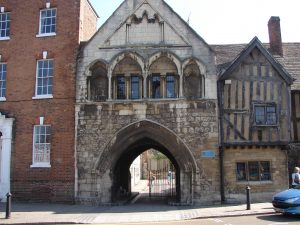 Gloucester Cathedral in England was a monastic church in 1392 and played an important role in Memento Mori, the third novel in my Lady Apollonia West Country Mysteries. In the 14th century, the present cathedral was the Abbey of Saint Peter which was the most important monastic house in Gloucester. I would like in this posting to discuss some of the abbey gates and walls which formed the abbey precincts in 1392.
Gloucester Cathedral in England was a monastic church in 1392 and played an important role in Memento Mori, the third novel in my Lady Apollonia West Country Mysteries. In the 14th century, the present cathedral was the Abbey of Saint Peter which was the most important monastic house in Gloucester. I would like in this posting to discuss some of the abbey gates and walls which formed the abbey precincts in 1392.
The cathedral close is an area of about twelve acres which were enclosed by stone walls in the 13th century to form the precincts of Saint Peter’s Abbey. The abbey church, sitting amid its monastic buildings, dominated the close. On the north side of this area, the abbey walls were part of the city’s defences. Elsewhere, these walls separated the monastery from the secular city. Access to the abbey was provided by gates of which three still exist today.
Saint Mary’s Gate is on the west side of the abbey precincts and was considered the main entrance. In my story, my heroine, Lady Apollonia, approached the abbey through this gate when she visited the abbey church. It is shown in the picture above which was taken from outside the cathedral close in 2012. There is a very picturesque building to the right of the gate, but its timber-framed upper storey was not erected until the 16th century. The stone, lower portion of that building is 13th century. Today, Saint Mary’s Gate faces Three Cocks Lane.
King Edward’s Gate is on the south side of the close, spanning a lane which runs from Westgate Street to what was then the burial ground of the abbey. It was built in the 13th century by King Edward I and was the gate through which the body of King Edward II passed when it was brought to the abbey for burial. The gate was remodelled in the 16th century, and some of it was dismantled in the 19th century. Still, the west tower remains on the lane which is now called College Street.
St Michael’s gate is also on the south side of the close but further east at the end of College Court. It is not referred in my novel, but is important to tourists today because it is next to the home which Beatrix Potter chose for her Tailor of Gloucester. That building now houses a shop and museum devoted to the world of Beatrix Potter.
Many of the abbey buildings are gone from the close, such as the refectory and dorter. The infirmary is just a few ruins. The abbot’s lodging in 1380 became the prior’s lodging when a new abbot’s lodging was built. That prior’s lodging is still attached to the church and is now known as Church House. The newer abbot’s lodging became the Bishop’s Palace when the abbey was dissolved and became a cathedral in the new Diocese of Gloucester. Other buildings on the east and south sides of the close were erected since the church became a cathedral.